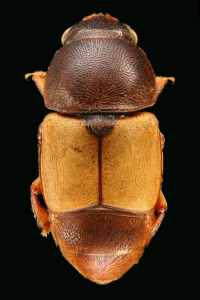Matrix-based keys, such as LucidTM keys, are superior to traditional dichotomous keys. They allow users to follow many paths to determine species, use subsets of characters, utilize non-tradtional characters (e.g., biological, geographical, phenology, genetic sequence data), utilize multi-state characters, and allow creators to incorporate extensive supporting graphics to aid in identification (Penev et al. 2009, 2012, Cerretti 2012). LucidTM keys are built around a data matrix of all available diagnostic characters scored for each taxon in the key. Identifications proceed by selecting any character in the key and indicating the state observed in the specimen. The software then eliminates taxa that do not match. This format makes the key “undirected”, allowing users to take multiple paths, skipping difficult, missing, or inapplicable characters, to identify specimens. Since undirected keys work by eliminating taxa that do not match the character states observed on the subject, users may choose more than one state option if uncertain. LucidTM provides a web hosting service, making these keys widely accessible for free to the scientific community and the general public. These many advantages allow LucidTM keys to be superior to dichotomous keys, especially when dealing with specimens that are difficult to identify.
The sap beetles in the family Nitidulidae are represented by 4,500 species in 350 genera worldwide (Slipinski, Leschen, and Lawrence, 2011). Of those, approximately 165 species in 30 genera are known in to occur in North America (Habeck, 2002). Carpophilinae is a subfamily of Nitidulidae represented by 3 genera and 21 species east of the Mississippi River, many of which are cosmopolitan.
Though traditional dichotomous keys to the Carpophilinae of the USA are available (Parsons 1943, Connell 1977, Connell 1991), they exclude several eastern species and rely on some difficult characters, limiting their usefulness. In addition, high quality graphics illustrating many species and difficult characters are lacking from those works. Carpophilines are often associated with ripe, rotting, or dried fruits and vegetables; however, many species have the ability to damage healthy fruit and transmit bacterial pathogens, making them pests of fruit industries (Leschen and Marris 2005). Due to their association with ripe and stored food crops, many species have become cosmopolitan due to international food trades. The ability for port and border inspectors to correctly identify detected carpophilines is paramount in preventing the entry of non-established species at ports of entry. Several species of Carpophilines also feed on pollen as adults. Therefore research has been ongoing to determine their usefulness as pollinators, especially for plants in the genus Annona (George et al. 1989, Tsukada Tanaka and Higuchi 2008, Higuchi et al. 2014). Currently, the best management techniques for Carpophilinae in stone fruits are field sanitation, harvesting fruits before they fully ripen, and using trap and kill bait stations to keep populations reduced (Hossain et al. 2006, Bartelt and Hossain 2006). Trap and kill bait stations rely on lures containing species-specific pheromones to capture beetles. In order to successfully utilize these traps, it is important to correctly identify the species involved so the correct pheromones can be deployed.
To aid in correct species identification of this difficult and important group, we developed a web-based LucidTM key to the Carpophilinae genera and species east of the Mississippi River in the USA and Canada.
HOW TO CITE THIS WORK:
DiLorenzo, C.L., G.S. Powell, A.R. Cline, and J.V. McHugh (2021) Carpophiline-ID, a taxonomic web resource for the identification of Carpophilinae (Nitidulidae) of eastern North America. (vers. 01.19.2021) University of Georgia, retrieved from https://site.caes.uga.edu/carpophiline-id/
